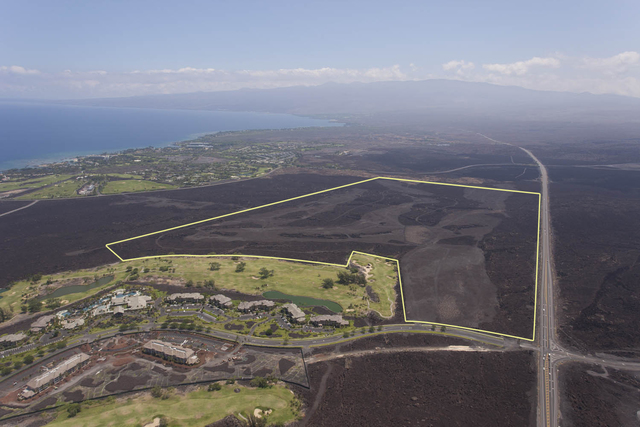WAIKOLOA — Hawaii Island’s efforts toward renewable energy and off-grid living took a giant leap with the inception of Ainamalu, a new Waikoloa community, which began construction this week. ADVERTISING WAIKOLOA — Hawaii Island’s efforts toward renewable energy and off-grid
WAIKOLOA — Hawaii Island’s efforts toward renewable energy and off-grid living took a giant leap with the inception of Ainamalu, a new Waikoloa community, which began construction this week.
The development will be a model of cutting-edge renewable technology.
Situated on 252 acres in South Kohala on the north side of Waikoloa Beach Resort, just makai of Queen Kaahumanu Highway, each home will have a 25-panel photovoltaic system on the roof and a Sony Blue Ion battery storage system.
When Brian Anderson purchased the land in 2014 he was thinking of creating a golf course community, the previous owners’ original plan, not green technology. But when he asked Waikoloa Land Company if they needed another golf course, the answer was no.
With that, the plan began to shift.
“So instead of a 21-acre golf course, there will be walking and jogging paths throughout the community,” said Sales Manager Lisa Barry.
“Looking at alternatives we kind of went with the model of the ahupuaa, which is a self-contained community. Our goal now is to have a zero carbon footprint and be totally green,” said Anderson. “We walked into Blue Planet Research about a year and a half ago and it’s kind of evolved on the energy side. The technology’s there. It’s just a matter of having the right project for it. We’re the perfect locale. We have more sunlight per year than probably any place else in the U.S.”
Blue Planet Research, located at Henk Roger’s Puu Waawaa Ranch in North Kona, has developed energy technology that has not only taken the ranch off the grid, but has demonstrated the efficacy of creating and storing hydrogen as a fuel using an electrolyzer and fuel cells. It can also replace propane.
Vincent Paul Ponthieux, director of Blue Planet Research, worked with Anderson to provide engineering consultation, storage technology and monitoring software to create a self-contained hybrid energy system. Each house will be connected to a central PV farm and battery storage facility. This will be monitored by EMCC (Environment Monitoring and Control Center), a specialized software program that will insure seamless power delivery.
“If any of the home systems either go down or get below a particular power level, the PV panel inverters — which are programmed with EMCC — can pull from the community PV storage facility. The houses are all wired underground to the community PV storage facility, which will be behind a 10-foot high berm,” said Ponthieux.
Also, if there are any unoccupied homes, the unused energy can be accessed by the rest of the community.
“The community will be a microgrid and each house is an island within the microgrid,” he said.
For a time, the community will have some backup for the backup.
“Each home is independent, but to be safe we have 2 megawatt hours of batteries that are backup to the community. Just because we’re the first ones doing this and I want my buyers to be comfortable that their Christmas lights are going to be turned on, we’re going to hook the 2 megawatt community battery to HELCO,” said Anderson.
Hawaii Unified Services will install the PV and storage systems.
Wastewater and sewage treatment are two other important elements in creating a self-contained community.
“The energy was one aspect and we’re working on wastewater and irrigation now. We have to make something that Waikoloa Land is very comfortable with aesthetically, as well as being operational,” said Anderson.
Part of the plan for wastewater treatment is to create a constructed wetland using grey water.
“We’re going to have our own wastewater treatment plant. We’re looking at different technologies now. Constructed wetlands are beautiful and it shows people what can be done with proper planning. It would have ponds and native plants,” he said.
Sewage treatment is another hurdle to clear.
“We’ve been looking at some different systems. There’s an anaerobic sealed tank and we’ve also been looking at an aerobic system,” Anderson said.
The Ainamalu sales office, located just off the highway, is a miniature model of the home designs.
“We opened the sales office informally. It’s a mini house. The colors and everything are identical to a normal house. Somebody can walk in and get a pretty good idea of the kitchen, color schemes and the selection of stone for the flooring,” he said.
Priced around $750,000 and situated on 15,000-square-foot lots, the homes will be constructed by HHB Builders based in Kona.
It will take the combined cooperative efforts of many to move forward into a future of energy independence and green living on Hawaii Island.
“This is a first effort. There are a lot of entities that want to be involved with us, such as HELCO and Hawaii Water. We just need to prove the technology. We’re not trying to do anything exclusive here. We want to work with everyone to find long-term solutions,” Anderson concluded.



